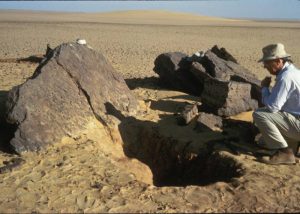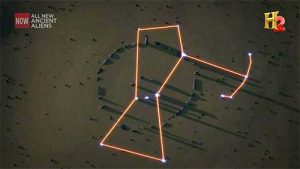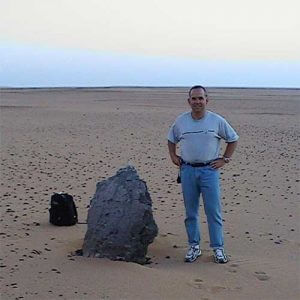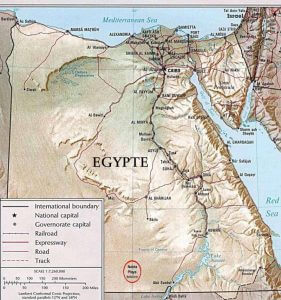
Abaddon
 26. 04. 2024
26. 04. 2024



 1
1
 26. 03. 2024
26. 03. 2024

For centuries, humanity has been trying to penetrate the mysteries of ancient Egypt. It is in this country that one of the most powerful and mysterious civilizations originated in ancient times. One of the unsolved puzzles remains the observatory in the Nubian Desert, Nabta Plaja, near the once dry lake (about 100 km west of Abu Simbel).
On sun-dried Egyptian land, there are often man-made objects whose meaning is not yet so clear to us. The ancient Egyptians have obviously put a lot of effort and wit into them, and modern man is trying to figure out what they were for.
One such building was discovered by American scientists in 1998 in Nabta Plaja. Archaeologists have found a stone circle of large massive blocks. Using the radiocarbon method, it was determined that the circle is at least 6500 years old and is therefore 1500 years older than the world-famous Stonehenge in England.
Random discovery
It should be noted that the strange megaliths in the middle of the desert were noticed by archaeologists as early as 1973, but at that time scientists were more interested in the shards of ceramic vessels for more than a few tons of stones.
Vertically placed massive stone blocks attracted the attention of experts only after twenty years. An expedition of scientists led by American anthropologist Fred Wendorf (from Southern Methodist University) traveled to the Nubian Desert in 1998 found that the huge monoliths were not accidentally "scattered" but formed an almost regular circle.
 After examining the find, Wendorf and astronomer John McKim Malville of the University of Colorado concluded that the structure was used to observe the stars. They described it as follows:
After examining the find, Wendorf and astronomer John McKim Malville of the University of Colorado concluded that the structure was used to observe the stars. They described it as follows:
"In the center of the megalithic circular structure, five stone monoliths, almost three meters high, are placed vertically. These columns in the center of the circle are designed to observe the Sun, which stands at its zenith at this point during the summer solstice.
If we connect one of the central menhirs with two stone blocks at a distance of 0,58 km, we get the line east - west.
The other two connectors, made in the same way, along similar lines, will determine the directions southwest and southeast. "
About 30 more stones are placed around the central part of the megalithic complex. And at a depth of four meters, a mysterious relief carved into the horizontal surface of the rock was discovered beneath this structure *.
Heaven Map, made of stone
The finding and exploration of Wendorf and Mallville was also studied by Californian physics professor Thomas Brophy for a long time. The results of his research are summarized in The Origin Map: Discovery of a Prehistoric, Megalithic, Astrophysical Map and Sculpture of the Universe, published in 2002.
He built a model that showed the starry sky over Nabta Plaja over the millennia and successfully solved the puzzle of the purpose of the stone circle and the nearby megaliths.
Brophy concludes that the structure, discovered in Nabta Plaja, shows a calendar of the motion of celestial bodies and an astrophysics map that contains incredibly accurate information about the constellation Orion.
The calendar circle has built-in meridian lines and parallels that helped Brophy figure out the circle  also used as an observatory. An observer standing at the northern end of the meridian 6000 years ago was directed at Orion with three stones at his feet. The connection between Earth and Orion is obvious: the three stones in a circle correspond to the position of the three stars in the Orion Belt before the summer solstice.
also used as an observatory. An observer standing at the northern end of the meridian 6000 years ago was directed at Orion with three stones at his feet. The connection between Earth and Orion is obvious: the three stones in a circle correspond to the position of the three stars in the Orion Belt before the summer solstice.
Thomas Brophy confided his findings to investigative journalist Linda Moulton Howe, a fan of historical riddles:
"The stone circle, which served as a calendar and was connected to the stars of Orion, is located about a kilometer north of the central megalith with vertical monoliths.
As I researched this calendar, I discovered stones whose position exactly matched the position of the stars in the Orion Belt. At the same time, according to calculations, the position of the stones corresponded to the position of the stars at sunrise on the day of the summer solstice in 4940 BC!
Further study of the stone calendar using computer technology led to even more surprising findings. A connection was discovered between the location of the other stones and the position of the visible stars of Orion on the day of the summer solstice in 16 BC! ”
According to Professor Brophy's theory, it is possible to use the megaliths in Nabta Plaja to follow the trajectory of the visible shift of the center of our galaxy, the Milky Way, which occurs every 25 years.
According to a Californian physicist, the probability that all of these matches are random is 2 in 1.
The only logical conclusion, Brophy believes, is that the distribution of the stones in Nabta Plaja and its compliance with the motion of the stars has been carefully calculated and is certainly not a coincidence.
Knowledge that is lost
 The question arises, how could Neolithic people who had no modern technology create a calendar capable of depicting the position of stars not only in their time, but also in a period more than 11 years away?
The question arises, how could Neolithic people who had no modern technology create a calendar capable of depicting the position of stars not only in their time, but also in a period more than 11 years away?
And here one, willingly or unwillingly, begins to trust some researchers who believe that at the time of the sinking of Atlantis, the surviving Atlanteans reached Egypt, established a new civilization, and shared their knowledge with the local population. And they formed a closed caste of priests.
There is also a theory that the civilization of Ancient Egypt was created by aliens who then left Earth. Deciphered ancient Egyptian inscriptions, often describing objects and people descending from the heavens and surrounded by bright light, could often be used as evidence.
The "people of heaven" brought technology to the Egyptians, taught them, and founded the pharaoh dynasties. There are also stories describing how these fiery people gave the Egyptians the technology of building pyramids of stone, mud and water.
Some surviving sources - the Texts of the Pyramids, the Palermo Plate, the Turin Papyrus and Maneht's writings - tell of the fact that in ancient times higher beings came to the land of Egypt and brought with them great knowledge. They created a caste of priests and with their disappearance their knowledge was gradually lost.
In any case, in today's conditions, we are able to compile a similar map only with the help of computers and on the basis of data obtained over many years of astronomical and astrophysical observations.
The old Egyptians themselves considered their calendar as a reference to other worlds. He was given to them in "The Times of Beginnings," so they called the period when darkness disappeared, and people received the gifts of civilization.
But there is also a more rational version of the explanation of the purpose of megaliths in Nabta Plaja. Archaeologists have evidence that people did not live in this place permanently. At that time, the lake was not yet dry, and the ancestors of the ancient Egyptians stayed with it only when the water level was high enough. During the period of drying heat, they went to other places, more suitable for life. And to determine the time of leaving the lake, they used a stone circle to help determine the summer solstice.
If Professor Brophy's conclusions about the connection between the circle and the constellation Orion were correct, there is nothing wrong with that  supernatural. The Orion Belt is one of the most visible objects in the starry sky, so it would be perfectly natural to orient the observatory according to it.
supernatural. The Orion Belt is one of the most visible objects in the starry sky, so it would be perfectly natural to orient the observatory according to it.
However, those who see in Nabta Plaja a map of the galaxy, left to us by the aliens from where they are unknown, continue their research and it is possible that they will soon be able to gain new knowledge about the ancient stones.
* dod. translating:
Shapes were carved into the rock, which Thomas Brophy later identified as a map of our galaxy. The relief depicts the Milky Way, but observed from space, tens of thousands of light-years away, the site of the North Galactic Pole, and 19 years ago. It is depicted faithfully there - in terms of position and scale, our Sun and the center of the galaxy. What surprised Brophy the most was that the dwarf galaxy in Sagittarius, which we discovered only in 000, is also depicted there.